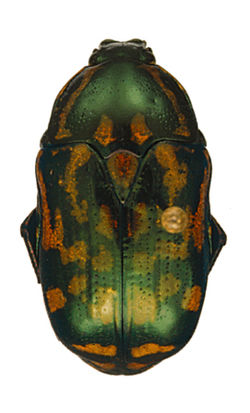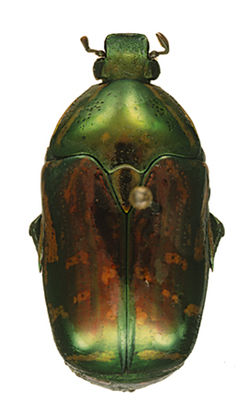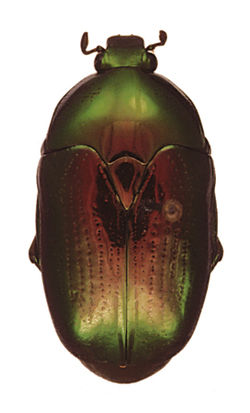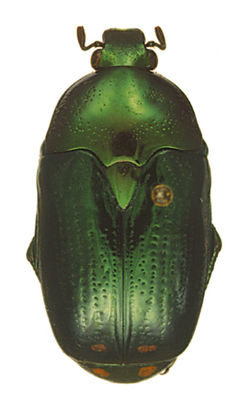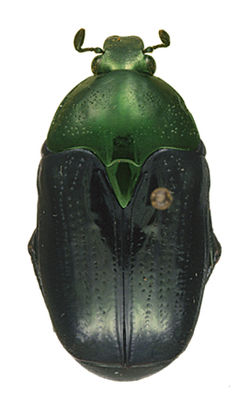|
Poecilopharis
Poecilopharis are beetles from the subfamily Cetoniinae, tribe Schizorhinini. The genus was created by Ernst Gustav Kraatz in 1880. The type of the genus is the species Schizorhina bouruensis Wallace, 1867. Metallic green in colour, often gaudy decorated with orange. Mesosternal process horizontal and flattened with raised tip. Protibia tridentate with long, tapering teeth grouped together at the tip. Clypeus tucked in, simply sinuate. Pronotum with the basal median lobe only covering the base of the scutellum. The genus is spread throughout the whole Australian region. List of the described species and subspecies
Details of the species and subspeciesSpecimens of Poecilopharis
The insect from the island of Erromango, New Hebrides. A large coppery species recalling emilia, but of a more stocky stature. Paramers resembling those of samuelsoni. The type specimen is in the Bernice P. Bishop Museum, Honolulu.
The insect from the Tanna island, smaller and more bluish. The type specimen is in the Bernice P. Bishop Museum, Honolulu.
The insect is chocolate colour, West Papua.
Smaller with a very weak elytral punctation from the Madang region.
Shiny dark green, orange marks reduced. From Nissan island. The type specimen is in the Allard's collection.
Described as Schizorhina aruana, close to leai, but slimmer, the punctation lines are more parallel. The type specimen is in the Paris Museum.
Insect from New Britain, very small, shiny, dark, with yellowish marks.
Described as Schizorhina buruensis, this insect from the eastern part of the Buru island is dark, shiny, olive green with a few residual yellow dots. The type specimen is in the Paris Museum.
From the western part of the Buru island, the insect is metallic golden green, the orange marks almost totally absent.
From the Larat island, a species with no punctation and of metallic green colour with copper red brilliance.
Shiny dark green, weak elytral punctation. From the New Hebrid (no more precise location). The type specimen is in the Paris Museum.
Described as Schizorhina emilia, an insect from the Anatom island, in the New Hebrides, small with a shiny greenish black colour, covered with regular orange patterns.
From the Arfak region, West Papua. Uniform dark green, legs copper red.
From the Vaté island, New Hebrides. Orange ground colour with greenish brown marks.
The insect from the island of Ghanongga, Solomon Islands. Cohabiting with uniformis with the two external teeth of the tibia close together and some differences in the paramers. The type specimen is in the Paris Museum.
The insect from the Nggela island, Solomon Islands. Close to woodfordi but less elongated, the patterns less clear and some differences in the paramers. The type specimen is in the Bernice P. Bishop Museum, Honolulu.
From the Choiseul island, has an unusual ending of the aedeagus.
Shiny, sparkling green, weak elytral orange maculation. From Guadalcanal, in the Solomon Islands. The type specimen is in the British Museum.
A small, black species with very small orange marks, living in the Rossel island. The type specimen is in the Paris Museum.
Close to moana, the edges of the elytral suture even less marked. The type specimen come from "Namanumi, Fleet island" (?).
The Australian insect from N. Queensland. It has double marginal band on the pronotum and a strong elytral punctation.
A very small species from the Larat island with a strong elytral punctation.
From the Moa island, copper green with an orange maculation.
A species from E. Sepik, Papua New Guinea. Ground colour olive black and a fine punctation. The type specimen is in the Paris Museum. Specimens of Poecilopharis
A species from the Yapen island. Small, shiny dark brown species with weak punctation. The type specimen is in the Museo Civico di Storia Naturale "Giacomo Doria", Italy.
A subspecies from the Fly river, Western Prov., Papua New Guinea. Much more coloured in appearance, with a much wider spatula. The type specimen is in the Bernice P. Bishop Museum, Honolulu.
The specimens from Madang have a similar spatula but the protibial teeth very tapering.
Green colour with gold and reddish reflections, weak orange maculation. From Rotuma (North of the Fiji islands). The type specimen is in the British Museum.
The species from New Ireland with a bronze colour and yellowish marks.
From the New Hebrides: Spiritu Santo and Malekula islands. A large species with extended yellow marks on a dark mauve background.
A species from Halmaera which makes the transition to the Anacamptorrhina, the tip of the clypeus being strongly indented. The type specimen is in the Paris Museum.
The insect from the Banks island, New Hebrides. Shiny blue green colour and general appearance different from the other currently known Poecilopharis. The type specimen is in the Bernice P. Bishop Museum, Honolulu and was dedicated to the great entomologist Dr. G. Allan Samuelson.
This is the species named aruana by Schoch in 1896. It comes from the Morobe Province, Papua New Guinea. The yellow patterns are of variable size.
From a place close to Bulolo, an insect usually small, with a very extensive orange maculation. The type specimen is in the Paris Museum.
A subspecies (or a true species) from Lufa, East Highlands Province, small size, chocolate colour with confluent yellow maculation. The type specimen is in the Paris Museum.
From the New Hebrides: Banks islands. A large species with a shiny light brown ground colour.
Described as Schizorhina truncatipennis, an insect from the Key island, with orange maculation in a black ground colour.
This is the insect from the south of the Solomon archipelago, almost a uniform dark green, the pronotum very little punctate.
The subspecies from the island of San Cristobal (now Makira), Solomon Islands. Uniform green colour with bright copper reflections. The type specimen is in the British Museum. Specimens of Poecilopharis
In the island of Ghizzo the specimens have a strong pronotal punctations. Same specimens exist also at the neighbouring island of Ganonggha.
This is the species from the Batjan island. The general appearance is dark copper red.
Described as Schizorhina whitei, an insect from the Aru and Key islands, with a shiny blue green colour.
The insect from the small island south of Bougainville is dark green with very few orange markings.
The specimens from Bougainville are strongly marked with orange, those from the island of Buka even having bronze reflections. The details of the paramers and of the first tibia have been published in the volume 25 of The Beetles of the World, together with a general distribution map. References
|
||||||||||||||||||||||||||
Portal di Ensiklopedia Dunia


